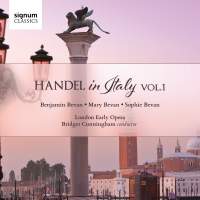Texte paru dans: / Appeared in: |
||||
|
Outil de traduction ~ (Très approximatif) |
||||
|
Reviewer: Bertil
van Boer Upon first seeing this disc, my eyes deceived me with the title, Handel in Italy, Vol. 1. Thinking it actually read Harold in Italy, it took a few moments to realize that Berlioz was not the topic here, but rather it intends to be the first in a sequence of recordings devoted to the early works of George Frédéric Handel. After this composers early in situ training as a continuo player at the Hamburg Opera, not to mention a couple of early operatic works there, he like so many others decided that he needed both the practical experience and possible acclaim that a sojourn in Italy would provide. Probably encouraged by a visit from Duke Gian Gastone de Medici, he sought the southern climes on his own accord, arriving there in 1706. His first port of call was Florence, and while there he no doubt made the acquaintance of some of the leading intellectuals of the time, and under their patronage moved on to Rome a year later, where achieved a reputation for both sacred music and operas. Within a year he had won the admiration of the Scarlattis and Corelli, embarking upon a successful career that ended abruptly in 1710 when he was “recalled” and offered the position of Kapellmeister at the court in Hannover. His Italian sojourn was not only educational; it was also lucrative, as Handel became the latest flavor of composer in his day. Although Protestant, he immediately became immersed in Catholic sacred music while in Rome, but his main focus was on opera, most of which were highly successful, and as a freelance composer, he found time to indulge in writing all manner of Italian style works for his various patrons. This disc gives a good cross-section of music that he wrote, both sacred and secular. It opens with the recently rediscovered Mass movement composed about 1707, probably his earliest Roman composition. Although part of the Mass Ordinary, its scoring for solo soprano and strings makes it more akin to a sacred cantata than a larger genre. It is an impressive work, especially in the final “Quoniam,” which is an opera aria with an extremely florid vocal line that would not be out of place in any opera seria. By the time one gets to the “Cum sancto spiritu,” the tempo increases substantially, racing towards a brilliant conclusion. This contrasts with the more introspective mode of the “Dominus Deus,” which seems to soar gracefully in a floating line. This substantial composition is complemented by a large cantata composed a year later in Naples. It was probably written for Antonio Manna, his first Polifemo in the serenata Aci, Galatea e Polifemo. The standard pairs of recitatives and arias are operatic in the extreme. The first aria tells of a ship rolling among the waves (allegorically, of course) with a rapid triplet figuration and leaps as the voice imitates the roiling sea. The final aria, in contrast, is lyrical lament, where the voice walks along lazily, save for the melismas required to demonstrate flexibility of voice. In between these two works are a series of bits and pieces. These include two arias from two theatrical works, the first the opera Agrippina performed in Venice and the second from an oratorio for a private performance in Rome. The first is a typical bravura aria, very virtuoso, with repeated echo effects and a wide range. Though perhaps not as cohesive as later works, it nonetheless demonstrates his ability to write convincingly for voice. The oratorio aria, “Un pensiero nemico,” is a rapid paced and extremely virtuoso furore aria. The vocal challenges far exceed those of the former, with a reduced central section that meanders and a highly expressive recapitulation. The passacaglia from the opera Rodrigo has a violin solo that seems almost concerto like, while the harpsichord sonata seems more north German in its folk-like themes and improvisatory sections.
The
performances on this disc are quite good. Conductor Bridget Cunningham seems
to have an excellent sense of how to bring out Handel’s often repetitive
sequences through a sense of adept phrasing. How she accomplishes this can
be seen in her fine performance of the sonata. The two sopranos have both
depth and flexibility, which are the primary components of a Baroque
operatic voice. Their sense of pitch is also extremely good. Baritone
Benjamin Bevan could be a bit more forceful in his tone, but he too is right
on target from the standpoint of interpretive skill. The performance by the
London Early Opera ensemble is suitably proficient, with a good sense of
what needs to be done to accompany the singers. This is a nicely programmed
disc, and I look forward to hearing the future volumes, which I suspect will
cover other aspects of Handel as an international composer. | ||||
|
||||
|
|
|
|||
|
Cliquez l'un ou l'autre
bouton pour découvrir bien d'autres critiques de CD |
||||




